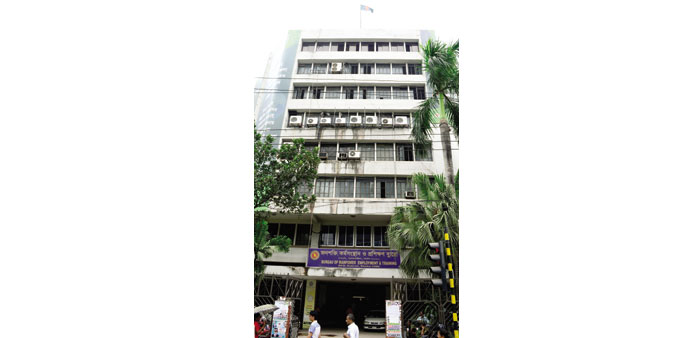GATEWAY: The BMET office in Dhaka. Photo by Anand Holla
One of the biggest suppliers of overseas workers, Bangladesh’s BMET has put in place high standards of recruitment and selection procedures
By Anand Holla
At Dhaka’s Bureau of Manpower, Employment and Training (BMET) office, dreams and livelihoods take wings by the hour, and the crowd never thins. Around 2,000 people walk by every day to get clearances to go abroad for work, and thereby continue to add colour to Bangladesh’s overseas employment success story.
At this point in time, 2.2mn Bangladeshi workers are all set to leave their country and work elsewhere as highly-skilled, skilled, semi-skilled or less-skilled workers. One of the biggest suppliers of manpower, Bangladesh has around 8.7mn nationals working in 159 countries across the world. Last year, 0.41mn Bangladeshis secured jobs abroad.
With World Cup 2022 preparations gathering steam in Qatar, BMET is getting more demand now from Qatar than ever before, says Mohammad Nizamuddin, Additional Director General of BMET. “Last year saw 57,584 Bangladeshis moving to Qatar for work. We are expecting this demand to only go up,” he says.
On any given day, more than 200 Bangladeshis come to Qatar to work. In the first 15 days of April, for instance, Qatar had 2,635 Bangladeshi workers flying in, second only to Oman which had 3,960 workers.
At Nizamuddin’s office, there’s a slogan stuck on top of the wall: Today’s investment in human resource; tomorrow’s prosperity. Given that Bangladesh’s remittance is six times more than its foreign aid and 10 times more than Foreign Direct Investment (FDI), the slogan makes a lot of sense.
“The remittance contributes to almost 12 % of our country’s GDP,” he says, of the $14bn a year that outsourcing manpower helps them get, making Bangladesh one of the top 10 remittance recipient countries in the world.
Currently, there are 1.94 lakh Bangladeshis in Qatar, and BMET feels the bilateral agreements between the two countries in recent years have helped Bangladesh fill in Qatar’s manpower requirement.
BMET was established in 1976 as an attached department of the then Ministry of Manpower Development and Social Welfare, so as to address the country’s manpower requirement and also export manpower. By being the nation’s core organisation handling such an important phenomenon, BMET has been instrumental in ensuring smooth sailing of the overseas employment dynamic.
“Our major functions are management of overseas employment, looking after the welfare of Bangladeshis working abroad, and providing vocational and technical training to cope with the local and global demand,” explains Nizamuddin.
By relying on training facilities like the 37 Technical Training Centres (TTC), 63 technical schools and colleges, 14 youth development centres, and 27 textile training centres, the manpower is empowered to take on various kinds of jobs in different sectors.
At BMET, the overseas employment process and emigration clearance has been streamlined and digitised. It starts with a person registering with the BMET database and applying for recruiting permission. The recruiting agency can then select workers as per the requirement by requesting the BMET, which maintains a workers’ database classified by their profession.
Following a medical test and visa procedures, the worker must undergo a finger print enrollment and emigration clearance from BMET before being briefed and sent off to a foreign country.
The BMET emigration clearance card has a secured 32KB microprocessor chip with encryption, and the employee’s essential information.
Abdul Latif Khan, Deputy Secretary, BMET, says, “The present law doesn’t allow middlemen to operate. Workers are being selected from the government’s central database to ensure transparency.”
“So if an employer from Qatar needs 100 masons, we sift through our database and give him 300, from which he can choose,” Khan adds.
“We seek to improve human resource development through vocational training. With training, we want to enhance knowledge and skill, increase employment opportunities and earn more remittance,” says Nizamuddin.
And how do they address the grievances of Bangladeshi expats? “When we receive complaints of abuse from our expat workers, we address that problem in phases. For instance, in 2005-06, we received a lot of complaints of abuse from housemaids. So we imposed a 21-day training course to empower them,” Nizamuddin says.
The year 2008 saw the biggest spike in the number of Bangladeshis working abroad at 875,055. But the global recession saw the numbers dip to 475,278 in 2009 and further to 390,702 in 2010, before stabilising again in 2011 and the following two years. From 1976 to 2013, Saudi Arabia has witnessed the maximum number of Bangladeshi workforce at 26.29 lakh followed by the UAE, while Qatar has had 2.67 lakh Bangladeshis moving in. The picture has changed quite a bit in 2013, as Qatar and Oman have emerged as the top draws for Bangladeshi workers.

